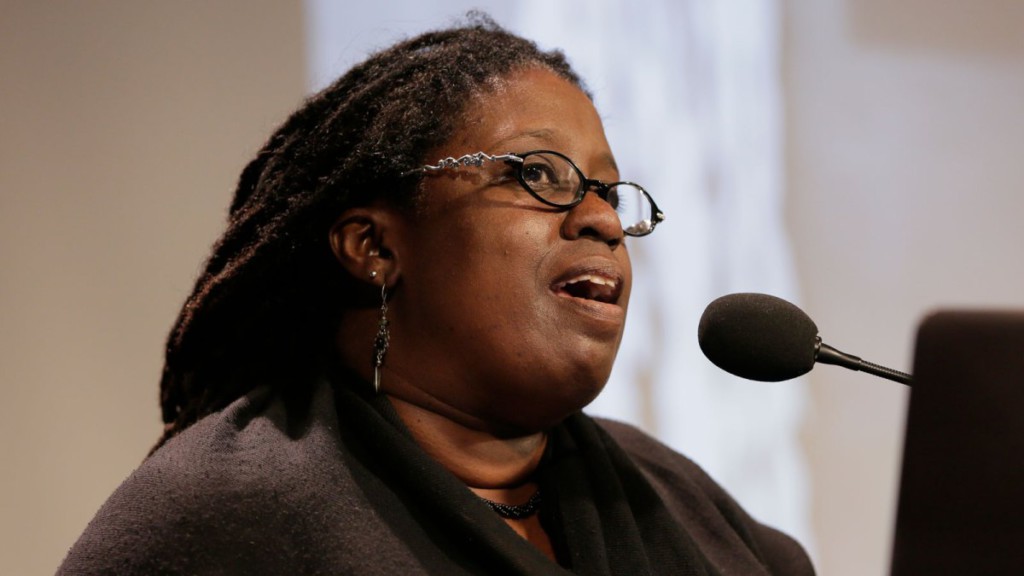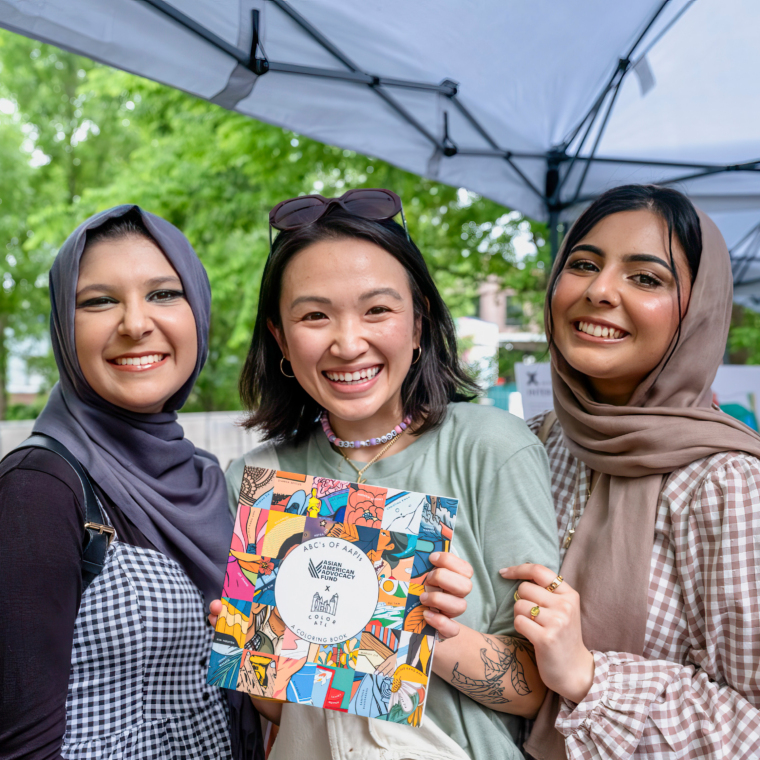
LGBT

As the climate crisis continues to be a defining issue of our time, climate justice leaders are pushing for systemic change and creating climate-resilient solutions. Representing the communities that are most urgently challenged by climate change, BIPOC leaders, particularly Black women, are stepping into the forefront of this movement.
Guided by its founder and executive director Jacqueline Patterson, The Chisholm Legacy Project (TCLP) centers leaders on the frontlines of advancing systems change by providing the resources and tools they need to transform society from an extractive economy to a sustainable, living economy. TCLP is a grantee of WE LEAD, a Tides Foundation-led initiative that was established to help resource women’s grassroots leadership on the frontlines of climate disruption.
Patterson was intentional about naming the project after Shirley Chisholm in homage to Chisholm’s revolutionary political organizing, and to uplift the labor, leadership, and well-being of Black women. Chisholm’s focus on gender and racial justice was uniquely bold during a time when Black women were discouraged from talking about women’s rights under pressure to just focus on race.

“Another thing we often see is that it’s Black femmes holding down so much of what’s happening, and yet they aren’t being held in the same way” (Photo © Environmental Change and Security Programs / CC BY-NC-ND 2.0)
As the founder of The Chisholm Legacy Project, please share its history and origin, and why it’s so important right now.
I had been working for almost 12 years at the NAACP [National Association for the Advancement of Colored People], founding and leading the environmental and climate justice program. Shirley Chisholm was an inspiration for the program because of her “unbought and unbossed” slogan. So often, fossil fuel and other industries sought to use the name of the NAACP to their own ends, and they saw our communities as vulnerable because of resources. There was a need for connecting Black frontline climate justice leadership to resources, ensuring that we had an expansive lens around race, gender, and other intersections, and that the community is at the core of our ethos.
Another thing we often see is that it’s Black femmes holding down so much of what’s happening, and yet they aren’t being held in the same way. With our work, we want to make sure that support, whether it’s coaching, restoration and respite retreats, or residencies, are all institutionalized in our organizational and movement infrastructure.
How did the pandemic impact the formation of the organization?
Before the pandemic, I was on the road 90% of the time, constantly traveling. And then everything came to a screeching halt. Having that time for reflection and inflection enabled me to think expansively about what can and should be, on a number of levels. I was on a panel with Steve Benjamin, the mayor of Columbia, South Carolina, at that time, and he said that COVID-19 “served as an x-ray to expose the broken bones of American society.” I sat down and spent 18 hours straight writing this document called the “Ten Equity Implications of the Coronavirus COVID-19 Outbreak in the United States.” I wasn’t prophetic by any stretch of the imagination, but anybody who is in the movement could see that COVID-19 took the well-worn path of inequity. As a result of both the acuteness and pervasiveness of the overlapping crises, people were forced to think in a different way about what is possible. This has brought a new level of creativity and motivation to make bigger systemic changes. Amidst it all, The Chisholm Legacy Project almost kind of took on a life of its own and grew organically from the convergence of all of these circumstances.”
What brought you into the work?
My undergraduate education resulted in a dual degree in special education and elementary education. A year after graduation, I went into the Peace Corps. Through my experience, I learned early on that a lot of the challenges around public health and the lack of provisions were rooted in systemic underpinnings, around power and corporations in how they govern so much decision-making in various nations, including the United States. After serving in the Peace Corps, I went on to study public health to understand the social determinants of health and how that ties in with our political and economic systems. My experiences as a public health practitioner domestically and internationally introduced me to firsthand observations of the intersection of climate change and gender justice around the world within the context of an extractive economy that is doing what it was designed to do: concentrate wealth and power into the hands of a very small few.

Jacqui Patterson speaking at the Climate Change and Children’s Health Press Conference in Harrisburg, PA (Photo © Moms Clean Air Force / CC BY-NC-SA 2.0)
Fast forward to my time at the NAACP, as we began to do the work, though our communities were on the frontlines of climate impact, the messaging around polar bears and ice caps gave the false impression that climate change was unrelated to our experiences. As such, we designed the program in such a way that we had a myriad of projects designed to aid communities in drawing connections between their everyday lives and climate change mitigation and adaptation measures. For example, when I went to a community and they said, “Well, we’re dealing with criminal justice and jobs,” and I said, “OK, how about if you work with us to pilot a program to provide jobs to formerly incarcerated persons through energy efficiency and solar installations?” It’s meeting people where they are, and having people see that there’s always a pathway to address climate change through projects that are multi-solving.
What is TCLP’s role in elevating the need for increased Black-led climate leadership in the broader environmental space, especially for Black women?
Ninety-five percent of funding for environmental work goes to white-led organizations. And yet, when you see so many of the victories that have happened, they were Black- or BIPOC-led, often Black women leading the work with very little. TCLP aims to lift up these victories while calling out what can be done with more investment, and the way successes can be scaled.
At the same time, as the book title This Bridge Called My Back goes, we cannot have this ongoing dynamic of putting more responsibility on Black femmes. We must honor, support, and ensure that they are held while they hold so very much.
What has been TCLP’s impact so far?
We’re participating in strategic planning with the Equitable Building Electrification Fund, the National Black Worker Center project, as well as EPA, NOAA, FERC, and beyond. With frontline communities, we are facilitating visioning, strategizing, action planning, and connecting people with technical and financial informational resources necessary to fulfill their community visions. TCLP is also working arm-in-arm with the Panafrican Climate Justice Alliance to center equity, justice, and Black liberation in the UN’s Framework Convention on Climate Change Conference of Parties, through organizing the African diaspora and paving pathways for inclusion and leadership.
Amidst all of the heartbreak and the suffering that our communities endure, we have to be intentional about finding joy. It helps in terms of healing and in sustaining ourselves in the journey.
What have been some challenges in doing this work and how do you navigate them?
Bringing my center back to purpose has been important in terms of navigating challenges. We have a movement that is driven by trauma, so it’s been important for me to be in peer relationships with others. At TCLP, we’ve also created a position called a cultural strategy manager, to integrate culture work into everything that we do. We’ve seen from others how powerful that has been, and how it’s such a source of healing for communities that have been traumatized from systemic and pervasive oppression on so many levels.
Amidst all of the heartbreak and the suffering that our communities endure, we have to be intentional about finding joy. It helps in terms of healing and in sustaining ourselves in the journey.
Five to 10 years from now, what do you envision for TCLP? What do you hope will emerge from the work?
Our goal within five years is that every Black American knows that we’re here for them, and that everyone has a sense of what they can do to advance the transition from an extractive economy to a solidarity economy. If we’re able to work with our communities where each community develops a vision and has that vision actualized in the form of creating microcosms of living economies, then hopefully we’ll have a thousand points of light that add up to a sea change. Our aim is also that Black femmes are living longer and more joyous lives. Only when we have made strides on all of these goals will we have begun to achieve our vision.

LGBT

Corporate Partners

Philanthropy

Read the stories and hear the voices of social change leaders fighting for justice.